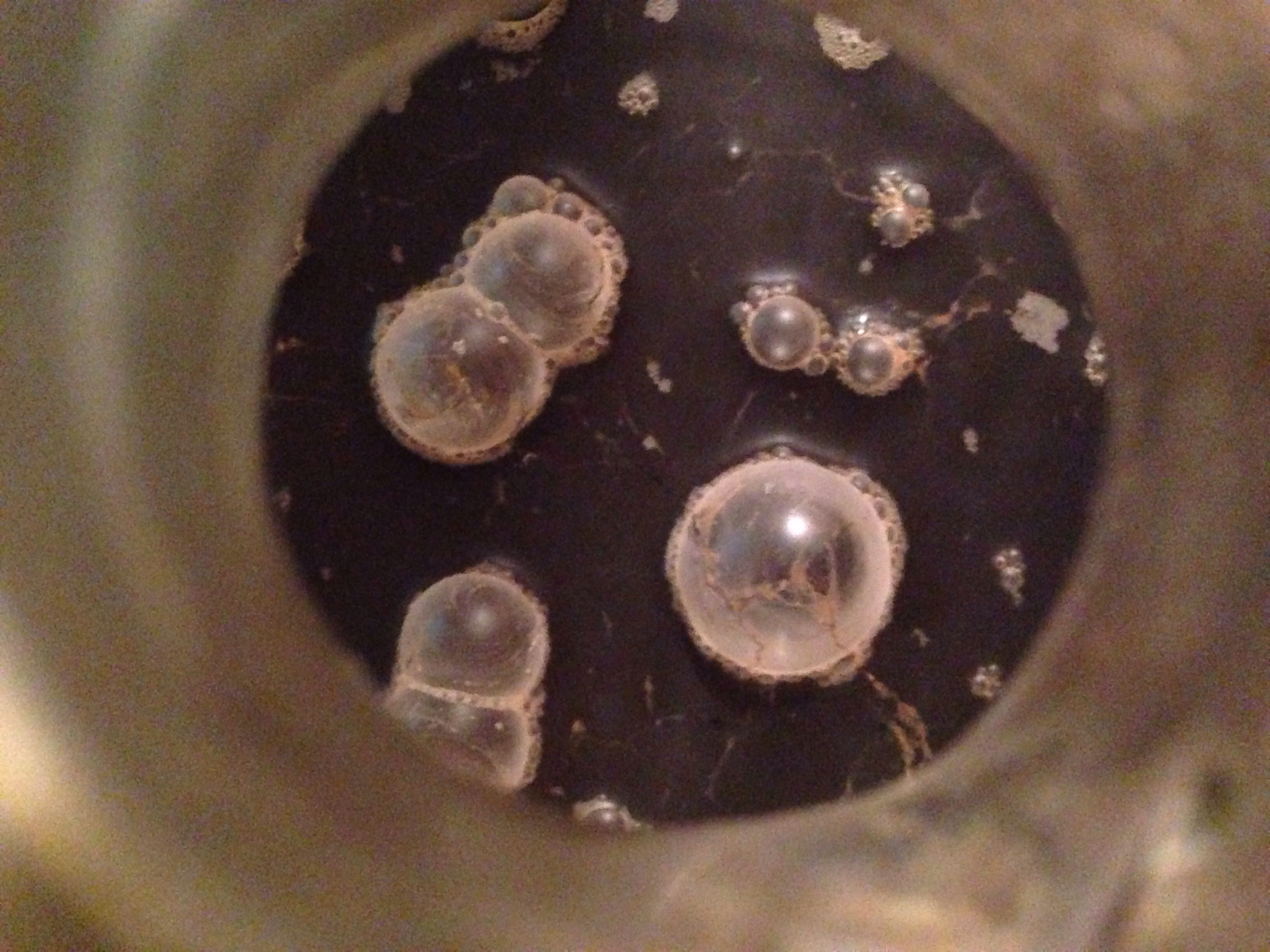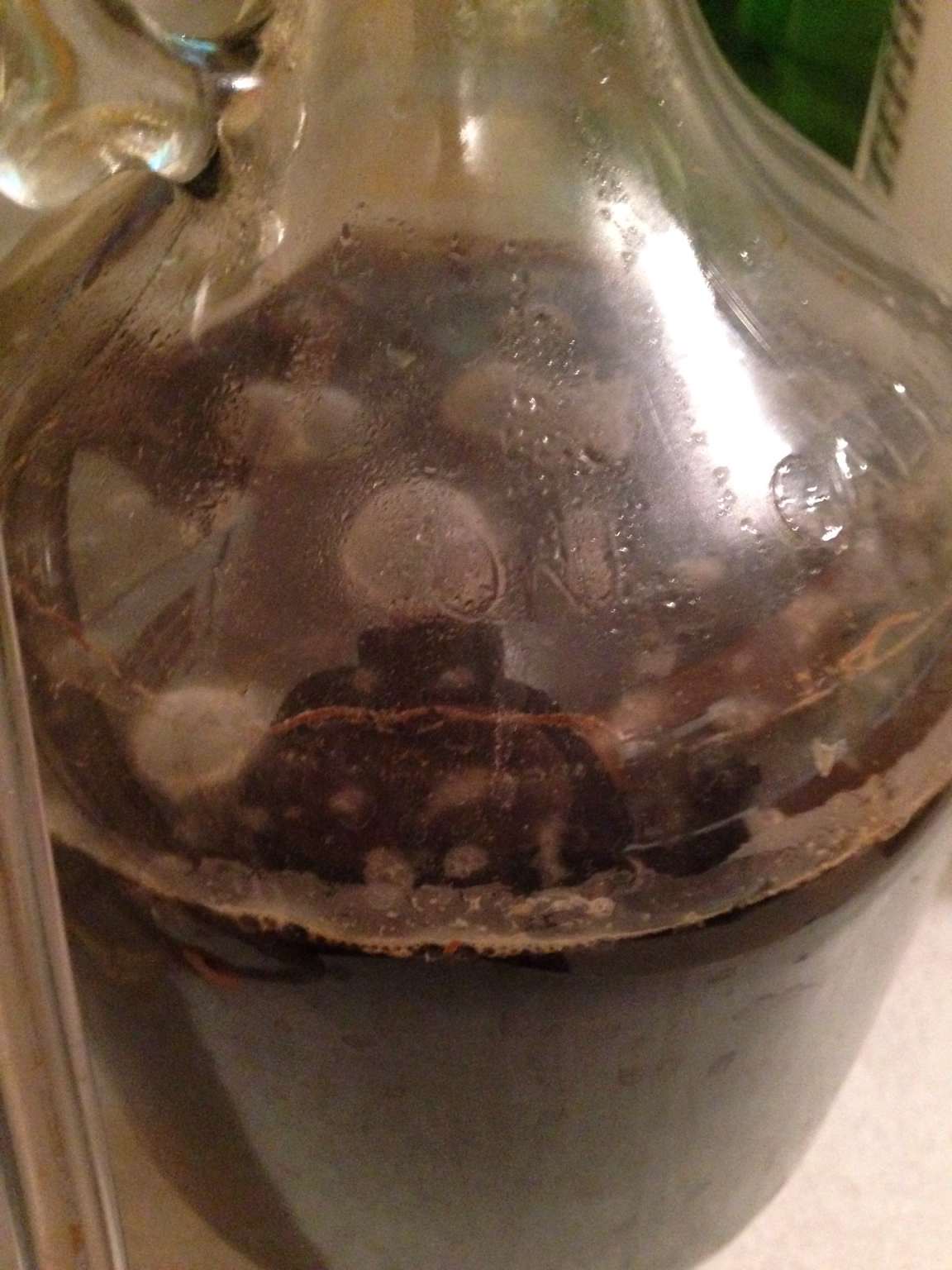I put my wort into secondary about a 2 weeks ago. This thin white film appeared right away, no signs of growth. There are some small white specs, again no growth. Going to crack it and giver a taste, but was just hoping to get some feedback.
You are using an out of date browser. It may not display this or other websites correctly.
You should upgrade or use an alternative browser.
You should upgrade or use an alternative browser.
Wort in Secondary, infection?
- Thread starter Allyster
- Start date

Help Support Homebrew Talk:
This site may earn a commission from merchant affiliate
links, including eBay, Amazon, and others.
It definitely doesn't look good. I assume this is beer? There is what appears to be a lot of headspace in there, and that can allow bacteria and other microbes to grow. If it tastes ok, you can bottle it up and drink it quickly, before it sours. Next time, I'd consider not racking to secondary at all, and instead bottling it at that point to avoid such issues.
Wort is what is made by brewing, but once the yeast is added it is considered beer. Wort would spoil very quickly, but once the yeast starts working it doesn't spoil so readily. How old is this beer?
Wort is what is made by brewing, but once the yeast is added it is considered beer. Wort would spoil very quickly, but once the yeast starts working it doesn't spoil so readily. How old is this beer?
eltorrente
Well-Known Member
Don't use secondaries. Waste of time and you will introduce your beer to oxygen. Just leave it in primary until you are ready to keg or bottle. The only time you should transfer to secondary is if you have fully purged your secondary, and even your lines, with CO2.
nh_homebrew
Well-Known Member
- Joined
- Mar 27, 2017
- Messages
- 101
- Reaction score
- 13
I have bubbles. Tastes okay. Way to much coffee. But plan on mixing it with another to dilute flavor. What do y'all think?


nh_homebrew
Well-Known Member
- Joined
- Mar 27, 2017
- Messages
- 101
- Reaction score
- 13

$58.16
HUIZHUGS Brewing Equipment Keg Ball Lock Faucet 30cm Reinforced Silicone Hose Secondary Fermentation Homebrew Kegging Brewing Equipment
xiangshuizhenzhanglingfengshop

$22.00 ($623.23 / Ounce)
AMZLMPKNTW Ball Lock Sample Faucet 30cm Reinforced Silicone Hose Secondary Fermentation Homebrew Kegging joyful
无为中南商贸有限公司

$10.99 ($31.16 / Ounce)
Hornindal Kveik Yeast for Homebrewing - Mead, Cider, Wine, Beer - 10g Packet - Saccharomyces Cerevisiae - Sold by Shadowhive.com
Shadowhive

$20.94
$29.99
The Brew Your Own Big Book of Clone Recipes: Featuring 300 Homebrew Recipes from Your Favorite Breweries
Amazon.com

$33.95
Five Star - 6022b_ - Star San - 32 Ounce - High Foaming Sanitizer
Bridgeview Beer and Wine Supply

$39.22 ($39.22 / Count)
Brewer's Best Home Brew Beer Ingredient Kit - 5 Gallon (Mexican Cerveza)
Amazon.com

$176.97
1pc Commercial Keg Manifold 2" Tri Clamp,Ball Lock Tapping Head,Pressure Gauge/Adjustable PRV for Kegging,Fermentation Control
hanhanbaihuoxiaoshoudian

$53.24
1pc Hose Barb/MFL 1.5" Tri Clamp to Ball Lock Post Liquid Gas Homebrew Kegging Fermentation Parts Brewer Hardware SUS304(Liquid Hose Barb)
Guangshui Weilu You Trading Co., Ltd

$27.29 ($13.64 / Count)
$41.99 ($21.00 / Count)
2 Pack 1 Gallon Large Fermentation Jars with 3 Airlocks and 2 SCREW Lids(100% Airtight Heavy Duty Lid w Silicone) - Wide Mouth Glass Jars w Scale Mark - Pickle Jars for Sauerkraut, Sourdough Starter
Qianfenie Direct
![Craft A Brew - Safale S-04 Dry Yeast - Fermentis - English Ale Dry Yeast - For English and American Ales and Hard Apple Ciders - Ingredients for Home Brewing - Beer Making Supplies - [1 Pack]](https://m.media-amazon.com/images/I/41fVGNh6JfL._SL500_.jpg)
$6.95 ($17.38 / Ounce)
$7.47 ($18.68 / Ounce)
Craft A Brew - Safale S-04 Dry Yeast - Fermentis - English Ale Dry Yeast - For English and American Ales and Hard Apple Ciders - Ingredients for Home Brewing - Beer Making Supplies - [1 Pack]
Hobby Homebrew

$7.79 ($7.79 / Count)
Craft A Brew - LalBrew Voss™ - Kveik Ale Yeast - For Craft Lagers - Ingredients for Home Brewing - Beer Making Supplies - (1 Pack)
Craft a Brew

$53.24
1pc Hose Barb/MFL 1.5" Tri Clamp to Ball Lock Post Liquid Gas Homebrew Kegging Fermentation Parts Brewer Hardware SUS304(Liquid Hose Barb)
yunchengshiyanhuqucuichendianzishangwuyouxiangongsi
nh_homebrew
Well-Known Member
- Joined
- Mar 27, 2017
- Messages
- 101
- Reaction score
- 13
That is for sure a pellicle, the way the bubbles are under the surface of the film confirm for me.
So pitch it?
Pitch it or save it for a year or so and see if you get a nice sour. The odds are heavily against that. If you taste it and it is OK, I might keg it and drink it fast before it really goes off. I would not bottle it. Bacteria can further ferment the beer slowly creating more co2 pressure than the bottles can handle. - bottle bombs.
Skip the secondary in the future. One less step that can introduce contaminates.
Skip the secondary in the future. One less step that can introduce contaminates.
For the OP, I can't tell from the pictures. Yooper knows what she is talking about so I would listen. In the third picture it looks like you have a glow worm in there.... 
nh_homebrew
Well-Known Member
- Joined
- Mar 27, 2017
- Messages
- 101
- Reaction score
- 13
I wonder if the coffee was too acidic. I brewed coffee and poured it in. I wanted to bottle it but it overflowed on putting priming sugar in.
The coffee acidity was not what caused the infection if that is what you are asking. Don't know what you mean by "it overflowed on putting priming sugar in."
RPh_Guy
Bringing Sour Back
+1 Pellicle (in nh_homebrew's photo, not the OP although it's hard to see)
+1 The pellicle simply indicates the presence of wild yeast and/or wild bacteria.
+1 Secondary usually isn't appropriate, but we don't know what his recipe was.
Wild microbe presence is not a health hazard.
If it tastes fine, monitor specific gravity for a few weeks to make sure it is stable. If stable, it is fine to package.
No need to leave it sit for a year.
No need to dump it.
@nh_homebrew
Boil about one cup of water to dissolve your priming sugar and then put that in your bottling bucket. Transfer the beer onto the priming sugar solution. You can very gently stir and/or leave it sit for 10-15 mins to make sure it's mixed thoroughly.
Fermented beer is lightly carbonated. Dumping in powder or granules provides nucleation points, rapidly releasing the carbonation. = Foaming and overflowing.
... I could be wrong but it sounds like that's what you're talking about.
Cheers
+1 The pellicle simply indicates the presence of wild yeast and/or wild bacteria.
+1 Secondary usually isn't appropriate, but we don't know what his recipe was.
Wild microbe presence is not a health hazard.
If it tastes fine, monitor specific gravity for a few weeks to make sure it is stable. If stable, it is fine to package.
No need to leave it sit for a year.
No need to dump it.
@nh_homebrew
Boil about one cup of water to dissolve your priming sugar and then put that in your bottling bucket. Transfer the beer onto the priming sugar solution. You can very gently stir and/or leave it sit for 10-15 mins to make sure it's mixed thoroughly.
Fermented beer is lightly carbonated. Dumping in powder or granules provides nucleation points, rapidly releasing the carbonation. = Foaming and overflowing.
... I could be wrong but it sounds like that's what you're talking about.
Cheers
Last edited:
nh_homebrew
Well-Known Member
- Joined
- Mar 27, 2017
- Messages
- 101
- Reaction score
- 13
+1 Pellicle.
+1 The pellicle simply indicates the presence of wild yeast and/or wild bacteria.
+1 Secondary usually isn't appropriate, but we don't know what his recipe was.
Wild microbe presence is not a health hazard.
If it tastes fine, monitor specific gravity for a few weeks to make sure it is stable. If stable, it is fine to package.
No need to leave it sit for a year.
No need to dump it.
@nh_homebrew
Boil about one cup of water to dissolve your priming sugar and then put that in your bottling bucket. Transfer the beer onto the priming sugar solution. You can very gently stir and/or leave it sit for 10-15 mins to make sure it's mixed thoroughly.
Fermented beer is lightly carbonated. Dumping in powder or granules provides nucleation points, rapidly releasing the carbonation. = Foaming and overflowing.
... I could be wrong but it sounds like that's what you're talking about.
Cheers
Thanks! I wish I waited for your post. I dumped it not wanting the jar to get more nasty. I did not know fermented beer is lightly carbonated. You understood me right about it overflowing. Though bottling other beer never did that for me. Knowledge for the future I guess. Cheers.
Similar threads
- Replies
- 26
- Views
- 1K
- Replies
- 10
- Views
- 2K

















































